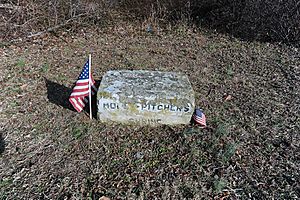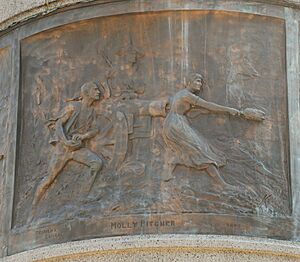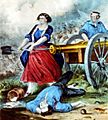Mary Hays (American Revolutionary War) facts for kids
Quick facts for kids
Mary Hays McCauley
|
|
|---|---|
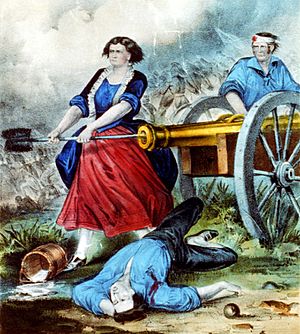
Mary Hays at the Battle of Monmouth, lithograph
|
|
| Birth name | Mary Ludwig |
| Born | October 13, 1754 Trenton, New Jersey, British America |
| Died | January 22, 1832 (aged 87) Carlisle, Pennsylvania, U.S. |
| Buried | (40°11′51″N 77°11′17″W / 40.19744°N 77.18797°W) |
| Allegiance | |
| Unit | Fire team 1 |
| Battles/wars | American Revolutionary War |
| Spouse(s) |
|
Mary Ludwig Hays (born October 13, 1754 – died January 22, 1832) was a brave woman who helped soldiers during the American Revolutionary War. She is often known as Molly Pitcher. This name comes from a famous story about a woman who fought at the Battle of Monmouth. It's possible the "Molly Pitcher" legend is a mix of stories about several women who helped on the battlefield that day.
Contents
Mary Hays' Life and Army Role
Mary Ludwig was born in Trenton, New Jersey. Her family included her older brother, Johann Martin. Her parents were Maria Margaretha and Johann George Ludwig. He worked as a butcher. Mary probably did not go to school. Learning to read was not common for girls at that time.
Her father passed away in 1769. Her mother then married John Hays. In 1777, Mary married William Hays. He was a barber in Carlisle, Pennsylvania. Records show that William was an artilleryman in the army. This means he worked with cannons.
Helping at Valley Forge
In 1777, William Hays joined the Continental Army. This was the main army fighting for America's freedom. During the cold winter of 1777, Mary Hays joined her husband. They were at the army's camp in Valley Forge, Pennsylvania.
Mary was one of many women who helped the soldiers. They washed clothes and blankets. They also cared for sick and dying soldiers. In early 1778, the army trained hard. Mary and other women carried water to the troops. They also brought water for the cannons. Cannons needed water to clean them after each shot. This is likely how Mary got her nickname. Soldiers would shout, "Molly! Pitcher!" when they needed water.
Bravery at the Battle of Monmouth
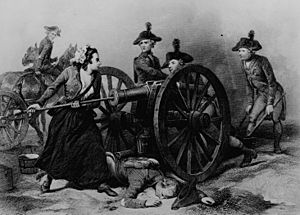
The Battle of Monmouth happened in June 1778. Mary Hays helped the soldiers by bringing them water. She found a spring to get her water from. Today, two spots on the battlefield are called the "Molly Pitcher Spring." She carried water to soldiers and cannon crews. She did this even while British troops were shooting.
The weather was very hot that day. William Hays, Mary's husband, collapsed during the battle. He was either hurt or very tired from the heat. It was once thought he died, but he actually survived. As he was carried away, Mary took his place at the cannon. She continued to clean and load the cannon. At one point, a British cannonball flew between her legs. It tore off the bottom of her skirt. She reportedly said, "Well, that could have been worse," and kept working.
A soldier named Joseph Plumb Martin wrote about a woman at the battle. She helped her husband at a cannon. A cannon shot passed between her legs. It carried away part of her skirt. She calmly said it was lucky it didn't hit higher. She then kept doing her job. This story is often linked to Mary Hays.
After the battle, General George Washington noticed Mary's courage. He had seen her loading a cannon. To honor her, he made her a non-commissioned officer. From then on, she was known as "Sergeant Molly." She used this nickname for the rest of her life.
Later Life and Legacy
After the war, Mary Hays and William returned to Carlisle, Pennsylvania. They had a son named Johannes. In 1786, William Hays passed away.
In 1793, Mary married John McCauley. He was also a veteran of the Revolutionary War. Mary continued to live in Carlisle. She worked as a servant, cleaning houses and caring for children. "Sergeant Molly" was a well-liked person in Carlisle. People often saw her wearing a striped skirt and a ruffled cap.
In 1822, the state of Pennsylvania gave Mary McCauley a yearly payment of $40. This was for her service in the war. Mary died on January 22, 1832, in Carlisle. She was about 87 years old. She is buried in the Old Graveyard in Carlisle. Her grave is marked with the name "Molly McCauley." A statue of "Molly Pitcher" with a cannon stands in the cemetery.
The Molly Pitcher Story
"Molly" was a common nickname for women named Mary during the Revolutionary War. Historians have learned a lot about Mary Ludwig Hays. We know about her family, her marriages, and her life. This helps us understand her story.
Historians believe that many of the brave actions in the Molly Pitcher story belong to Mary Ludwig Hays. However, some also think "Molly Pitcher" is a general name. It might represent many women who helped during the war. Hundreds of women served by carrying water, helping with cannons, and caring for soldiers.
How Mary Hays is Remembered
Mary Ludwig Hays is honored as Molly Pitcher in several places. There is a monument to her in Freehold, New Jersey. Her grave in Carlisle, Pennsylvania, also remembers her.
The Monmouth battlefield has a stone marker for the Molly Pitcher Spring. A painting of Mary in battle was made for a post office. It is now in the Monmouth County Library headquarters.
Images for kids
See also
 In Spanish: Molly Pitcher para niños
In Spanish: Molly Pitcher para niños


